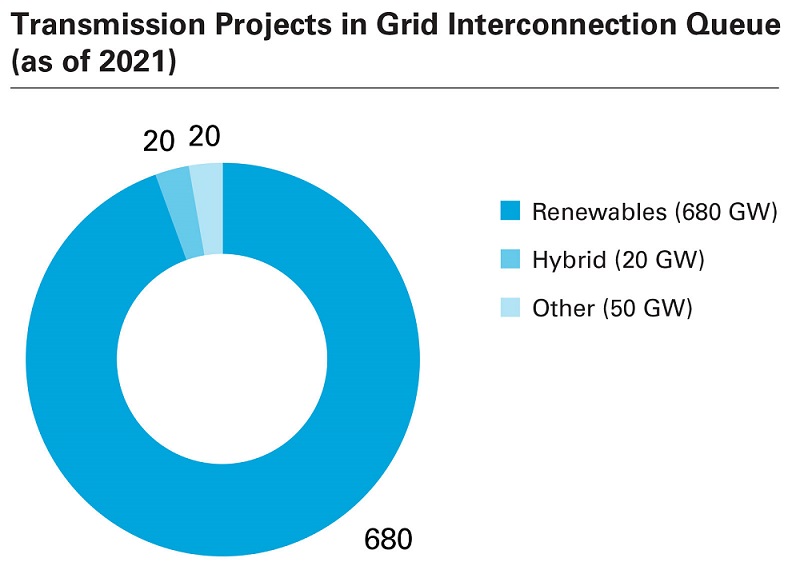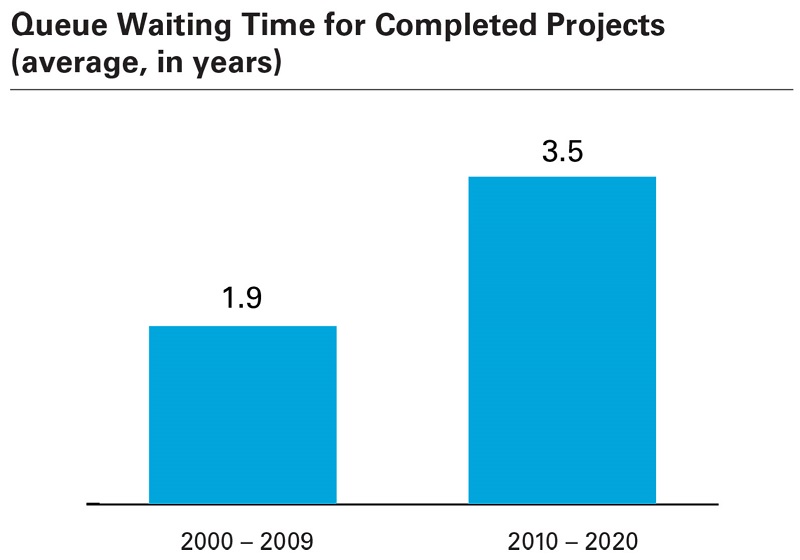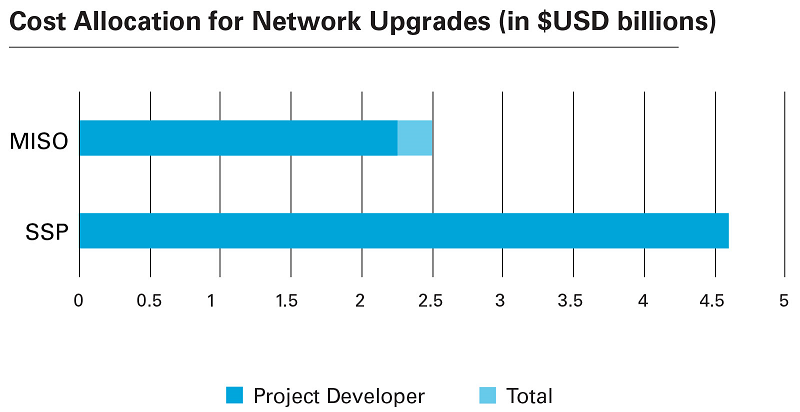
Building on the sweeping climate and energy goals set forth by the Biden administration, the spotlight turns to transmission development and power grid infrastructure. An array of federal and state proposals may usher in a wave of capital and interest toward necessary renewables-adjacent transmission projects, but the practice may deviate from the proposals.
The Business Case for Transmission Buildout
Connecting Rural Renewables to Urban Usage
Once an overlooked—and underfunded—segment of domestic power markets, transmission infrastructure is now the subject of renewed focus in the energy sector. As renewable generation achieves economies of scale and penetrates more areas across the US, it has become imperative to pair clean power with an attendant modern grid. While a variety of programs, incentives, and tax credits have bolstered the fortunes of wind and solar generation, the amount of transmission to send power to customers and ratepayers has not been commensurate.
Typically, renewable generation facilities are sited on more remote parcels of land where the resource is plentiful and there is sufficient space to accommodate turbines or panels. Wind and solar facilities require at least ten times as much land relative to fossil fuel generation.1 In many cases, the generation facility has been sited independent of any transmission consideration. Due to the high proportion of demand located elsewhere, and often beyond the reach of the generations-old legacy grid infrastructure, there is a clear and demonstrated need for modern, new transmission. For instance, onshore wind is heavily concentrated in the Great Plains and Upper Midwest regions of the US; without accompanying transmission lines, that renewable generation capacity will serve less demand, a missed opportunity to dovetail new infrastructure with the pursuit of climate aims.
Designing broader transmission systems should also improve grid reliability and resilience in light of higher penetration of intermittent resources. No matter the location, the demands of a power grid can be variable and vulnerable to a number of factors. When incorporating more solar and wind resources, the weather plays an outsized role if there is insufficient transmission infrastructure and/or electric storage—both of which are commonplace at present. However, researchers believe that a substantial multi-regional transmission buildout will, in effect, "smooth out" such variability.2 Investments in large-scale transmission could be more financially prudent than locally over-investing in generation, as well as more accretive to climate goals and grid reliability.
Accelerating and Streamlining Interconnection Queues
As utilities, electric co-operatives, and other entities supplying retail power pursue compliance with climate initiatives at municipal, state, and now federal levels, the logical next step is ensuring such renewable generation can be transmitted to denser clusters of demand at greater distances—to cities, data centers, commercial facilities, and industrial plants. Rules and regulations can stymie this progress in certain locales. A bloated queue of generator interconnection proposals has indeed hampered the ability for renewable generators to access transmission systems and subsequently provide electric services. In a queue, each proposed generator interconnection project undergoes a system impact study, which models and assesses how the new project would affect the balance and operation of existing grid infrastructure.
Governed by the regional grid operators (each under federal oversight), this process establishes what new equipment, upgrades, or retrofits may be required before a project can interconnect to the system and assigns the costs of that equipment. The regional entities may also appraise the suitability of a proposed project based on its existing resource mix, reliability factors, and other parameters that reflect how a new or modified interconnection point would alter grid operations. Collectively, the list of such projects under review and in progress are considered generator interconnection queues.
Renewable capacity in generator interconnection queues has grown year over year. As of 2021, the queues included over 755 gigawatts (GW) of generation capacity. Solar and wind comprised the vast majority at 680 GW; furthermore, an estimated 200 GW of electric storage capacity was in queues, a common complement to renewable projects. The amount already in queues may represent 70 percent of the projected capacity to meet the Biden administration’s clean energy target of 80 percent emissions-free power generation by 2030.4
However, the completion rate for projects languishing in interconnection queues has been abysmal. Even for those projects that ultimately achieve commercial operation, average wait times while in the queues has nearly doubled over the past decade. Renewables-associated transmission proposals fared worse than conventional projects, with a 19 percent completion rate for wind and 16 percent for solar, respectively, compared to 24 percent overall.5
This summer, the California Independent System Operator Corporation (CAISO, the regional grid operator in California under federal jurisdiction), extended the timeline for evaluating projects in its 2021 generator interconnection queue.6 The Federal Energy Regulatory Commission (FERC) approved the revisions due to an "unprecedented" volume of requests in the current queue cluster—373 in total comprising 150,000 MW in generating capacity. FERC found that this substantial increase from 155 requests in 2020 warranted a delay to the extent of several months in order for CAISO to accommodate the deluge of queue submissions. In the approval order, FERC stated that extending this deadline earlier in the process rather than at a more advanced stage "will provide greater certainty to interconnection customers, transmission owners, load-serving entities, and other market participants."
On a related note, however, CAISO recently identified two specific interconnection sites that would be integral to "mitigat[ing] potential capacity shortfalls, outages, and contingencies CAISO may face imminently."7 CAISO petitioned FERC to waive the study process for these two projects, noting the emergency declaration issued by the Governor of California in July of 2021, preemptively accounting for exogenous factors such as extreme weather and wildfires in the state. FERC approved waivers of the respective interconnection request processes, citing the limited nature (due to the declaration by the Governor) and concrete justification for grid reliability. While this waiver approval indicates that CAISO and FERC both acknowledge queue-related issues, this remedy is purely an ad hoc solution precipitated by a state political mandate and not necessarily indicative of a broader trend in clearing hurdles in the generator interconnection process.
Despite slow queue efficiency across regions on first glance, the complexity of the study process—required for every proposal, regardless if it is a new facility or a retrofitted conventional facility—is an ever-present barrier to quick evaluation. In addition, the regional grid operators take up each proposal as it was submitted sequentially, so there is no priority granted to larger projects or projects that may serve a pressing need such as resolving congestion (barring a limited instance such as the CAISO waiver discussed above). The sheer volume of projects submitted into the generator interconnection queues has also blunted progress, but regulators are generally aware of the issue and have implemented some new measures, as outlined in more detail below.
Regulatory Regimes and Restraints
FERC Jurisdiction
The Federal Energy Regulatory Commission (FERC) has jurisdiction over interstate transmission of electricity. Pursuant to its authority vested in the Federal Power Act, FERC has oversight over wholesale transmission rates. It is important to note that FERC does not directly evaluate or review the approval process for the construction of new lines and facilities; states hold that power and, as discussed later, the siting and permitting processes are often impeded by local interests. Meanwhile, FERC is tasked with ratemaking and cost recovery of transmission infrastructure. FERC plays a major role in the transmission sector by devising new rules, regulations, and policy statements that the regional grid operators under its purview (except ERCOT in Texas) must adhere to.
FERC-jurisdictional transmission providers are required to provide interconnection service under the terms of an Open Access Transmission Tariff. Generators have the right to request interconnection services separately from transmission services. In response to complaints by generators that interconnection procedures were being used by some transmission providers in a discriminatory manner, FERC implemented rules to standardize agreements and procedures for generators and required FERC-jurisdictional transmission providers to interconnect generators to the grid in a non-discriminatory manner. Under the standard interconnection procedures, generators are required to pay the full cost of any interconnection facilities up front (from the generator to the point of interconnection) and network transmission facilities (beyond the point of interconnection) necessary to connect the generator with the transmission grid. The generator is then reimbursed for the cost of any network transmission facilities through credits for future transmission service on the grid.
Transmission projects traditionally secure revenue through a FERC proceeding where the agency establishes cost-of-service rates based on the calculated return on equity (ROE) that the developer receives. FERC carries out this analysis in concert with the regional grid operators, utilities, and stakeholders. The costs associated with large-scale transmission facilities are spread among market participants, known as the beneficiary-pays principle; in reality, however, this practice has been cited as discriminatory to renewable generators and may be ripe for reform. Generators may be required to pay for improvements to existing transmission lines in order to accommodate the proposed increased load, known as network upgrade costs.
In two regional grid entities—the Midcontinent Independent System Operator (MISO) and Southwestern Power Pool (SPP)—project developers for new generation are assigned nearly the full costs of transmission upgrades. According to each of the most recent planning phase studies by MISO and SPP, 9.2 GW and 10.4 GW of (mostly renewable) new generation would require $2.5 billion and $4.6 billion of transmission investments, respectively.8 Under current cost assignment rules, generators in MISO pay 90 percent of cost upgrades, while generators in SPP are directly responsible for all costs.
The diffusion of benefits by new generation to all parties in power markets may lead FERC to contemplate modifying this practice and sharing network upgrade costs among participants without solely burdening the new generator. As illustrated prior, the beneficiary-pays principle is seemingly failing to assign actual costs to all entities where new generation, and associated transmission, bolsters the grid and provides value-add services.
Merchant transmission—where the project developer negotiates directly with its intended customer (i.e., an electric utility or generator)—has not yet made a significant footprint in the markets, but is another potential mechanism to finance and build transmission lines. Nonetheless, merchant transmission lines still must comply with FERC interconnection rules and processes irrespective of the preceding financing arrangement.
State Jurisdiction
While FERC holds authority in the financing, planning, and interconnection of transmission projects, states control permitting and siting. Most states have codified siting considerations in their respective laws, delineating clear procedures in order to grant approval for new transmission. In such states, the electric utility proposing to construct a transmission facility must demonstrate to the state siting authority that the new line is necessary and serves the economic and public interest. Only a few states simply require that a notice of intent is filed and, if the proposal is not contested by stakeholders or competing utilities, the transmission line is then granted permission to proceed with right-of-way acquisitions and construction activities.
Historically, this fragmented system for siting new power lines, in addition to other factors such as the federal-state nexus of regulations associated with transmission cost recovery, has been a barrier to the development of new transmission in the US. The Energy Policy Act of 2005 (EPAct 2005) aimed to provide tools to facilitate new construction and improvements to existing transmission infrastructure.
EPAct 2005 directed the Department of Energy (DoE) to conduct nationwide studies of electric transmission congestion to identify areas in which transmission capacity constraints or congestion adversely affects consumers and designate such areas as national interest electric transmission corridors (NIETCs). EPAct 2005 gave FERC supplemental permitting authority to ensure timely construction of transmission facilities to remedy transmission congestion in those corridors. DoE initially designated two such corridors in 2007, but the US Court of Appeals for the Ninth Circuit vacated and remanded the designations to the DoE. In addition, the US Court of Appeals for the Fourth Circuit limited the supplemental backstop siting authority of FERC vested in EPAct 2005, ruling that it applied only in situations where a state refuses to act on a permit application or imposes uneconomic conditions, but determined FERC lacked the authority to overrule a state denial of a permit application. Thus, a state may be able to circumvent FERC backstop siting authority by properly denying an application, or merely failing to act.
In sum, states wield this siting power quite effectively; many projects have failed due to issues or opposition at the state level rather than federal. Developers and utilities must account for the unique local and state circumstances in order to achieve commercial operation. The federal and state regulatory regimes and processes are siloed, so garnering federal approvals does not automatically lead to a favorable—or eventual—state outcome.
Prior FERC Action
FERC has issued a number of landmark orders relating to transmission in the past, principally Order No. 888 (issued in 1996) and Order No. 1000 (issued in 2011). The former opened up wholesale competition in the markets by requiring transmission owners and operators to provide non-discriminatory access to services; the latter facilitated the participation of regional planning processes for transmission.
Neither order, nor others not expressly mentioned, has fully modernized and incentivized the massive grid buildout that industry observers and policymakers believe is necessary to meet the ambitious climate agenda of the Biden administration. Order No. 1000 has been especially scrutinized in recent years, as its intent to expand transmission while improving equitable cost allocation has yielded mixed results. As discussed earlier, large transmission lines can boost the outlook for renewables, but Order No. 1000 unintentionally included a loophole provision where smaller projects are not compelled to enter into a competitive bidding process and therefore are easier to propose and build than larger counterparts.
Further, as explained earlier in this piece, generator interconnection rules (under FERC oversight and carried out by the regional grid operators) have ostensibly led to the queue backlog hindering hundreds of renewable generating facilities from entering commercial operation. In light of the slow generator interconnection queues, FERC has standardized and streamlined the processes and procedures for generator interconnection agreements,9 partly to unclog queues and partly to encourage accurate and timely information sharing. For example, in Order No. 845 issued in 2019, FERC instituted quarterly reporting requirements for transmission providers to report interconnection study performance data, accessible through public websites.10 Order No. 845 also set out requirements for transmission providers to notify FERC if its interconnection study deadlines are exceeded for more than 25 percent of any study type for two consecutive calendar quarters. These efforts by FERC appear to demonstrate a willingness to acknowledge and improve the transparency of generator interconnection procedures.
Regulatory Reform on the Horizon
FERC Initiates New Rulemaking Proceeding
In July of 2021, FERC issued an Advanced Notice of Proposed Rulemaking (ANOPR) on transmission reform. The ANOPR signals that FERC recognizes the impetus to tackle issues in transmission by deploying, in their words, a holistic approach. Namely, FERC will solicit comments from stakeholders and industry participants in three main areas:
- Longer-term regional transmission planning and the cost allocation process, incorporating anticipated future generation additions
- Generator interconnection network upgrade cost responsibility assignments
- Enhanced oversight and monitoring of identification and financing for new transmission facilities
FERC also raises the prospect of integrating new, and independent, oversight of the planning process separate from existing regional grid operators. The potential transmission monitor would report directly to FERC if problems arose in transmission planning. By renouncing some of its vested authority, FERC could prioritize the goal (best practices) rather than strict adherence to a method. In effect, FERC may be addressing the purported shortfalls of Order No. 1000 and is proactively seeking better oversight in transmission planning reform.
In addition, the ANOPR asks for input relating to potential geographic zones that may be optimally suited for large-scale renewable development with associated transmission infrastructure. FERC is likely drawing inspiration from the Competitive Renewable Energy Zones (CREZ) system in Texas, a program that ran from 2005 to 2013. Overall, the CREZ facilitated the buildout of transmission lines from resource-rich areas of the state to cities in other areas of the state. Upon its completion, CREZ resulted in 3,500 miles of transmission lines carrying (mostly wind) power throughout Texas. By highlighting the potential for similar geographic zones, FERC may be able to boost economic activity—and, by proxy, grid reliability—in less dense parts of the country while serving the overarching goal of transmission infrastructure expansion.
The ANOPR also calls for comments on grid-enhancing technologies, an indirect way to strengthen the grid and alleviate pressure (and costs) on transmission systems. Grid-enhancing technologies, such as dynamic line ratings, would be considered during interconnection studies carried out by transmission providers in order to fully account for the range of accretive services available.
Additionally, FERC created a joint federal-state task force with the National Association of Regulatory Utility Commissioners (NARUC) on this issue. The FERC-NARUC task force will be composed of ten members, each from separate regions of the US, assessing the existing rules and proposed new provisions in transmission.
At time of publication, comments were due to FERC in mid-October and reply comments due in mid-November. Barring any timeline extensions or unforeseen circumstances, FERC will expect to issue a Notice of Proposed Rulemaking by winter and potentially a Final Rule (which would reflect the regulatory text) in mid-to-late 2022.
Federal Legislation and Funding
Biden Budget Proposal
In support of his Build Back Better agenda, President Biden and congressional Democrats introduced a $3.5 trillion framework for spending programs during the 117th legislative session. The proposal focuses on the key pillars of the Biden agenda, beginning in Fiscal Year 2022 and spanning throughout the decade. The Energy and Natural Resources Committee of the Senate included $198 billion toward clean energy initiatives, including the Clean Electricity Performance Program, domestic manufacturing in the clean energy and electric vehicle supply chains, and procurement of energy efficient materials. As it stands, the budget proposal has moved forward in a partisan fashion; the Senate passed the resolution by a 50-49 party-line vote in August of 2021. Similarly, the House of Representatives voted 220-212 in favor of the Democrats, but the outlook of the budget resolution is uncertain due to opposition by some Senate Democrats.
Bipartisan Infrastructure Bill
A bipartisan piece of legislation, entitled the Infrastructure Investment and Jobs Act (IIJA),11 is also under consideration by Congress. The $1.5 trillion bill carves out $73 billion specifically for the power grid. Accounting for the House Energy and Commerce portion of the bill,12 approximately $28 billion would go towards transmission-related infrastructure, as outlined below.
| Provision | Allocation | Bill Section | Funding Deadline |
| Preventing grid outages and enhancing resilience against disruptive events (i.e., severe weather and wildfires) | $5 billion | 1001 | September 30, 2026 |
| Research, development, and demonstrations of grid reliability projects | $5 billion | 1003 | September 30, 2026 |
| Improvement of safety and cost-effectiveness of transmission siting in rural or remote areas | $1 billion | 1003 | September 30, 2026 |
| "Transmission Facilitation Fund" for construction of non-federal transmission lines and facilities | $2.5 billion | 1007 | Borrowing Authority |
| Technology deployment to enhance and synergize grid flexibility; Smart Grid Investment Matching Grant Program | $3 billion | 1008 | September 30, 2026 |
| Technology deployment to enhance and synergize grid flexibility; Smart Grid Investment Matching Grant Program | $3 billion | 1008 | September 30, 2026 |
| Construction, acquisition, and replacement of Federal Columbia River Power System under authority of the Bonneville Power Administration | $2 billion | 1011 | Borrowing Authority |
| Public-private partnerships with electric utilities to promote and advance physical security and cybersecurity of grid infrastructure | n/a | 1101 | n/a |
| Advanced cybersecurity of the bulk power system; technical assistance to rural and municipal utilities | $250 million | 1104 | September 30, 2026 |
| Enhanced grid security measures via vulnerability identification, risk assessment, pilot demonstration projects, workforce training, and supply chain improvements | $250 million | 1105 | September 30, 2026 |
| Grants and loans for transmission lines and interties | $8 billion | 30461 | September 30, 2031 |
| Technical assistance grants to regional transmission organizations (RTOs) and independent system operator (ISOs) | $100 million | 30463 | September 30, 2031 |
Perhaps equally important as the billions in proposed spending, IIJA would clear the way for transmission development. For instance, IIJA would establish the Grid Deployment Authority, a new federal entity under DoE oversight. According to the White House, the Grid Deployment Authority would help finance and facilitate the expansion of major transmission lines—and possibly circumvent lengthy permitting and siting processes—by leveraging existing public rights-of-way used for highways, roads, and railways.
Moreover, FERC would be vested authority to overrule state regulatory agencies who deny project permits in DoE-designated transmission corridors. In the past, this authority only applied to decisions on natural gas pipelines. By granting FERC the ability to supersede these state-level decisions, the backlog in the generator interconnection queue may be resolved and bring hundreds of renewable GWs onto the grid.
Outlook
As outlined in detail above, there are currently a number of potentially significant developments and reforms at play to modernize transmission. Some proposals dovetail with overarching climate goals and synergize with the expansion of renewable energy, while others approach transmission from a more practical infrastructure perspective. In any event, the outcomes are far from settled—there is both tremendous opportunity in the domestic energy landscape and complexity as to how, and when, it may materialize in practice.
1 Renewables, Land Use, and Local Opposition in the United States, Brookings Institution. January 2020. Available at: https://www.brookings.edu/wp-content/uploads/2020/01/FP_20200113_renewables_land_use_local_opposition_gross.pdf.
2 Transmission Planning for 100% Clean Electricity, Energy Systems Integration Group. February 2021. Available at: https://www.esig.energy/wp-content/uploads/2021/02/Transmission-Planning-White-Paper.pdf.
3 Testimony of FERC commissioner Allison Clements, US House of Representatives Committee on Energy & Commerce, Subcommittee on Energy. July 27, 2021.
4 2030: The Report, Goldman School of Public Policy at the University of California Berkeley. April 2021. Available at: https://gspp.berkeley.edu/faculty-and-impact/centers/cepp/projects/2030-report-powering-americas-clean-economy.
5 Queued Up: Characteristics of Power Plants Seeking Transmission Interconnection, Lawrence Berkeley National Laboratory. May 2021. Available at: https://eta-publications.lbl.gov/sites/default/files/queued_up_may_2021.pdf.
6 176 FERC ¶ 61,207, Order Accepting Tariff Revisions. September 24, 2021. Available at: https://elibrary.ferc.gov/eLibrary/filelist?accession_num=20210924-3077.
7 176 FERC ¶ 61,159, Order Granting Request for Waiver. September 15, 2021. Available at: https://elibrary.ferc.gov/eLibrary/filelist?accession_number=20210915-3084.
8 Just & Reasonable? Transmission Upgrades Charged to Interconnecting Generators Are Delivering System-Wide Benefits, American Council of Renewable Energy. September 2021. Available at: https://acore.org/wp-content/uploads/2021/09/Just-Reasonable-Transmission-Upgrades-Charged-to-Interconnecting-Generators-Are-Delivering-System-Wide-Benefits.pdf.
9 Electric Transmission: Generator Interconnection, Federal Energy Regulatory Commission. Available at: https://www.ferc.gov/industries-data/electric/electric-transmission/generator-interconnection.
10 166 FERC 61,137 at ¶ 97, 98. Available at: https://www.ferc.gov/sites/default/files/2020-06/Order-845-A.pdf.
11 Energy Infrastructure Act, S. 2377, 117th Congress 1st Session. July 17, 2021. Available at: https://www.energy.senate.gov/services/files/50847FFD-724B-4BB4-94E0-D8E1FC9C7ABC.
12 Budget Reconciliation Legislative Recommendations Relating to Energy, House Committee on Energy & Commerce. September 13, 2021. Available at: https://energycommerce.house.gov/sites/democrats.energycommerce.house.gov/files/documents/Subtitle%20D_Energy.pdf.
White & Case means the international legal practice comprising White & Case LLP, a New York State registered limited liability partnership, White & Case LLP, a limited liability partnership incorporated under English law and all other affiliated partnerships, companies and entities.
This article is prepared for the general information of interested persons. It is not, and does not attempt to be, comprehensive in nature. Due to the general nature of its content, it should not be regarded as legal advice.
© 2021 White & Case LLP




